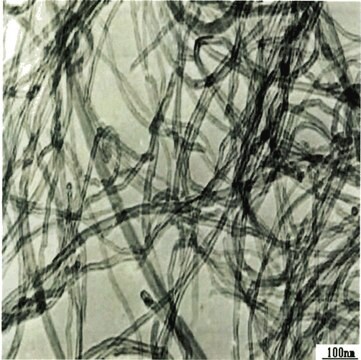901082
Carbon nanotube sheet
aligned, size × thickness 100 mm × 100 mm × 1-5 μm
Sinónimos:
MWCNT, MWNT, Multiwall carbon nanotube
About This Item
Productos recomendados
Quality Level
assay
>95% (carbon)
resistivity
10-1000 Ω/sq
size × thickness
100 mm × 100 mm × 1-5 μm
diameter
10-40 nm (carbon nanotubes)
¿Está buscando productos similares? Visita Guía de comparación de productos
General description
CNT has a multi-walled structure. Crystal quality of CNT is examined by Raman scattering measurement. Intensity ratio of G-peak (1580 cm-1) and D-peak (1350 cm-1) represents quality of graphitization of carbon materials. G/D of CNT is ∼3, showing high crystal quality. The high crystallinity is supported by transmission electron microscopy.
Preparation Note
Storage Class
11 - Combustible Solids
wgk_germany
WGK 3
flash_point_f
Not applicable
flash_point_c
Not applicable
Elija entre una de las versiones más recientes:
Certificados de análisis (COA)
¿No ve la versión correcta?
Si necesita una versión concreta, puede buscar un certificado específico por el número de lote.
¿Ya tiene este producto?
Encuentre la documentación para los productos que ha comprado recientemente en la Biblioteca de documentos.
Los clientes también vieron
Artículos
A drawable Carbon Nanotube (CNT) array is a special type of CNT forest, in which individual nanotubes are aligned and grown vertically on a substrate through a chemical vapor deposition (CVD) process. Most strikingly, a macroscopically aligned, pure, and pristine CNT sheet can be continuously drawn out of the array, parallel to the drawing direction, as a result of a delicate interactive force established between neighboring CNTs. Carbon nanotube array has opened the door to practical applications of carbon nanotubes and multifunctional CNT composites, enabling exciting future innovations
Professor Rivnay (Northwestern University, USA) discusses using organic mixed conductors as an alternative to efficiently bridge the ionic world of biology with contemporary microelectronics.
Dr. Tan and researcher introduce recent trends in Self-healing Soft Electronic Materials and Devices. The emergence of smart, functional SHPs will be highly beneficial to the advancement of the next-generation self-healing soft electronic devices. Autonomously self-healing devices could help to minimize the need for repair or replacement of electronics and machines, potentially reducing the cost of materials and reducing electronic waste.
Synthesis and Applications of Graphene Nanoribbons Synthesized
Nuestro equipo de científicos tiene experiencia en todas las áreas de investigación: Ciencias de la vida, Ciencia de los materiales, Síntesis química, Cromatografía, Analítica y muchas otras.
Póngase en contacto con el Servicio técnico





